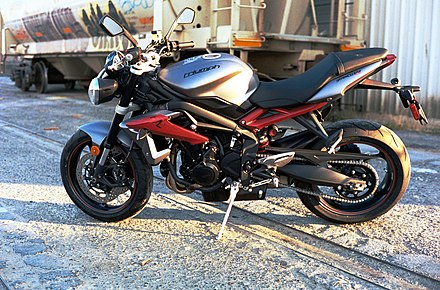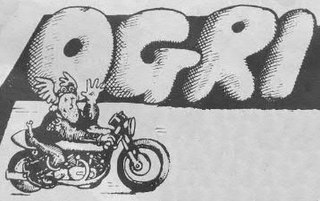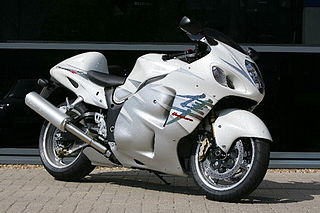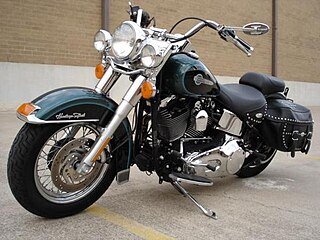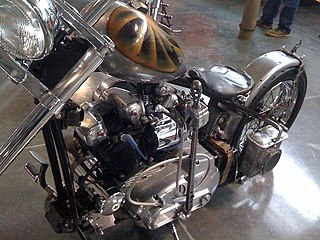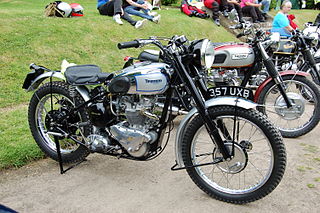
A streetfighter is a sport bike that is customized by removing the fairing, and making other changes that result in an overall more agressive look. [1] [2] Beyond simply removing fairings, specific changes that exemplify the streetfighter look are a pair of large, round headlights, tall, upright handlebars such as those on a motocross bike, and short, loud, lightweight silencers. Streetfighters is also the name of a UK motorcycle magazine. [3]

A sportbike, or sports bike, is a motorcycle optimized for speed, acceleration, braking, and cornering on paved roads, typically at the expense of comfort and fuel economy by comparison with other motorcycles. Soichiro Honda wrote in the owner's manual of the 1959 Honda CB92 Benly Super Sport that, "Primarily, essentials of the motorcycle consists in the speed and the thrill," while Cycle World's Kevin Cameron says that, "A sportbike is a motorcycle whose enjoyment consists mainly from its ability to perform on all types of paved highway – its cornering ability, its handling, its thrilling acceleration and braking power, even its speed."

A custom motorcycle is a motorcycle with stylistic and/or structural changes to the 'standard' mass-produced machine offered by major manufacturers. Custom motorcycles might be unique, or built in limited quantities. While individual motorcyclists have altered the appearance of their machines since the very first days of motorcycling, the first individualized motorcycles specifically labeled 'Custom' appeared in the late 1950s, around the same time as the term was applied to custom cars. In the 1960s, custom artisans like Arlen Ness and Ben Hardy created new styles of custom bikes, the chopper. In the 1990s and early 2000s, very expensive customs such as those built by Orange County Choppers, Jesse James's West Coast Choppers, Roger Goldammer became fashionable status symbols. There are also companies that are bringing back pin striping, such as Kenny Howard and Dean Jeffries from the 1950s, with a continued effort to keep pin striping alive. The choppers of the 1960s and 1970s fit into this category.

A motorcycle fairing is a shell placed over the frame of some motorcycles, especially racing motorcycles and sport bikes, with the primary purpose to reduce air drag. The secondary functions are the protection of the rider from airborne hazards and wind-induced hypothermia and of the engine components in the case of an accident. A motorcycle windshield will almost always be integrated into the design of the fairing.
Contents
Later streetfighters used custom-built frames intended to overcome the weakness of the tubular steel frames of the early 4-cylinder superbikes of the 1970s and 1980s. Many of these frames turned out to be "beautifully crafted pieces of metallurgical art," perhaps only unintentionally. [4] Many were also originally racing machines. [5]
Made popular by European riders, [6] this type of custom motorcycle gained worldwide popularity, and motorcycle manufacturers responded in the late 1990s by adopting the terminology [7] and producing factory-built streetfighters, beginning with the 1994 Triumph Speed Triple [8] and the 1999 Honda X11, [9] up through the 2009 Ducati Streetfighter.
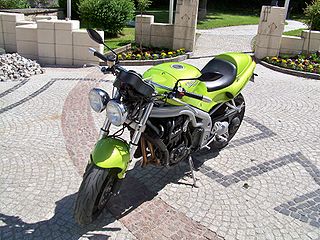
The Triumph Speed Triple is a series of motorcycles produced by Triumph Motorcycles. In 1994 the reborn Hinkley Triumph became one of the first production motorcycles to embrace the new streetfighter style, which was essentially a modern sport bike or race replica motorcycle but without the aerodynamic plastic fairing. The style began when bikers who, having crashed their race replicas, put the bikes back on the road sans fairing, mainly for reasons of economy.

The Honda X11 is a standard motorcycle produced by Honda with a 1,137 cc (69.4 cu in) liquid-cooled, inline-four engine and a 1990s-style cooling unit at its fore end. It is based on the CBR1100XX Super Blackbird.

The Ducati Streetfighter is a streetfighter-style motorcycle produced by Ducati. The Streetfighter was designed by Damien Basset of the Ducati design team. Ducati sold the Streetfighter in three variations – the Streetfighter 1099 cc from 2009 to 2011, the Streetfighter S 1099 cc from 2009 to 2012, and the Streetfighter 848 849 cc from 2011 to 2015.

